It's one of the questions we hear most often from travelers … and one of the hardest to accurately answer: “Will I make this connection?”
The threat of missing a flight because of a tight connection looms over us all. Travelers are rightfully concerned as delays and cancellations are an unfortunately common occurrence in the airline industry, making what should have been an easy connection stressful – or even impossible. But there's no one-size-fits-all answer for what connections are safe and which might be cutting it close.
It depends upon where you're going and which airport you're connecting through; whether you're flying domestically, internationally, or a mix of the two; whether you'll need to re-clear security, re-check a bag, or both; how you booked your tickets; and other factors. Plus, every traveler is different: Seasoned veterans who know an airport well might be fine with a 30-minute connection while even two hours may not be long enough for a first-timer heading abroad.
So while we can't give you a black-and-white answer, we do have some general guidelines that can help you decide what's safe when booking one- or two-stop flights – including some notoriously bad airports where you might want to be extra cautious.
Ground Rules for Your Layover
Between bad weather, mechanical issues, and other incidents, making your connection isn't always within your control.
That's why it pays to play it safe if you're worried. When booking flights with a layover, our general rule of thumb is 60 to 90 minutes for a domestic flight and at least two and a half hours for international itineraries.
But it's not always so black and white. There are some additional questions you may want to consider when booking flights with connections.
Is Your Trip Booked on the Same Itinerary?
If you booked your connecting flights as one ticket – on the same itinerary – you can breathe easy.
When an airline sells you a ticket, the carrier is making a promise to get you to your final destination. If that ticket includes a connection but you wind up missing the second segment due to a delay on the first flight, the airline is obligated to put you on the next available flight to your final destination.
So let's say you book an early morning Delta flight from Fargo (FAR) to Chicago-O'Hare (ORD) with a pitstop in Minneapolis-St. Paul (MSP). Thanks to a delay getting off the ground in North Dakota, you can't make that second flight to Chicago. No problem: Delta has to put you on the next available flight – preferably, the one that lands around 11:30 a.m.

One or two-stop journeys booked as part of a single reservation together protect you if one of the legs of your trip is delayed or canceled. If your first flight lands too late to catch the second segment, the airline has to put you on the next flight with seats available.
It might require chatting with a gate agent, calling the airline, or sending a message, but you won't be stuck. Unless you're on a strict schedule, that means there's less reason to stress about short connections.
There's no overarching rule for how short a layover can be. Carriers set that number individually at each airport based upon how long it should take to make a connection, assuming everything goes smoothly. And airlines only sell tickets with connections that meet that minimum requirement.
So while a 50-minute layover in Dallas-Fort Worth (DFW) on your way to Santiago, Chile (SCL) may not seem long enough to you, the airline is confident it will be.
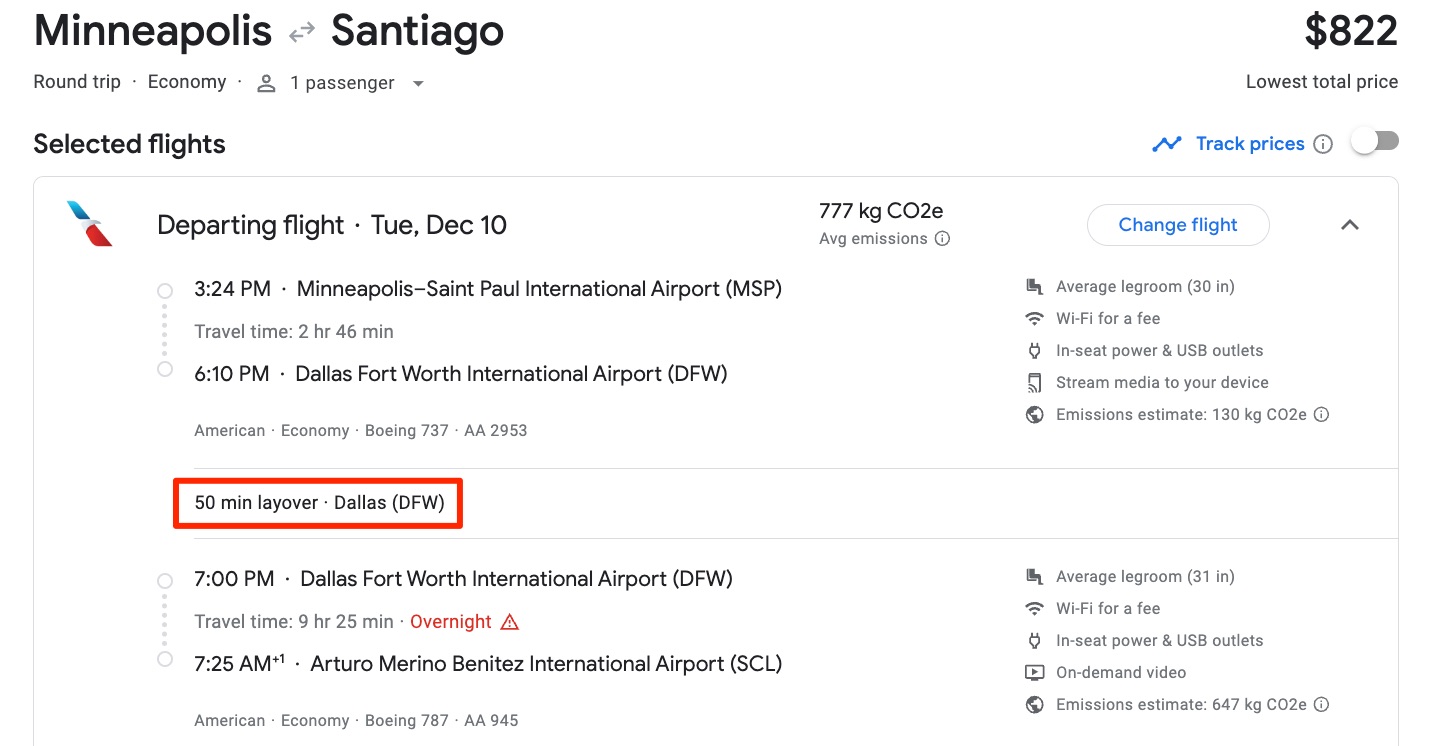
There's even less cause for concern if you're connecting from one domestic flight to another on the same airline, as your gates will likely be close together. Getting off the plane could take more time than walking to your gate.
All that said … if a longer layover makes you more comfortable, go for that option. Better safe than sorry, right?
While hanging out in the airport isn't always fun (especially if you don't have lounge access), it's better than missing a flight and derailing your trip. It could be worth paying more for a flight with a longer layover to avoid any additional stress.
Are You on Separately Booked Flights?
Positioning flights are one of the best ways to save on international flights. But the reward of a cheaper fare comes with a much higher risk of missing a connection.
Positioning flights are short domestic flights you take between your home airport and a second, larger hub in order to hop on a cheaper international fare. It's an easy trick to save on a long flight abroad when prices from your home airport are too high – especially when it helps you take advantage of a good business class deal or an award ticket.
But unlike your typical one-stop journeys booked together on one ticket, you have to book positioning flights separately – maybe even on different airlines. And there's the rub: Because they're not part of the same reservation, these are unprotected connections. Airlines aren't obligated to help you rebook if you land too late or miss your second flight.
So if you're booking a positioning flight, give yourself far more time between flights. That way, you have some wiggle room should something go wrong.
For example, we recently took a positioning flight from Minneapolis-St. Paul (MSP) to New York City (JFK) to fly ITA Airways business class to Italy. The TripIt itinerary shows just how long of a buffer we gave ourselves to ensure we didn't miss that important flight to Rome (FCO).
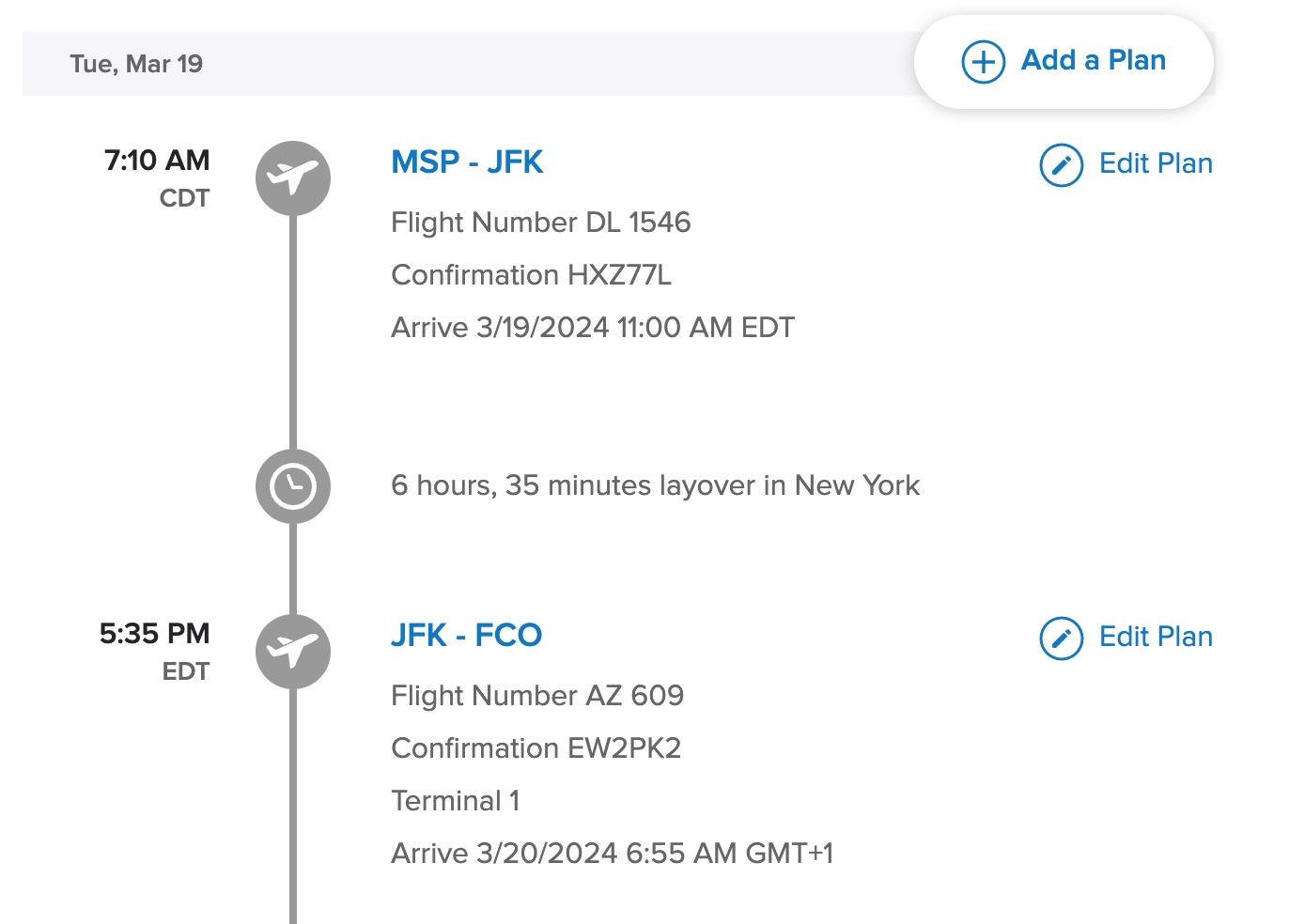
We built in a six-hour, 35-minute layover between the two flights, and it was a good thing: My flight took off from Minneapolis more than an hour behind schedule.
Even with that delay, we still had plenty of time to get from the gate in JFK to take the train from Terminal 4 to Terminal 1, check in for the flight to Rome (FCO), check a bag, and re-clear security. Had we booked the next Delta flight to New York that morning, however, we might have missed the flight to Rome. Whew.
Only you can decide what you're comfortable with. But if you ask us, it's probably safest to give yourself at least three to four hours of connection time between when your positioning flight lands and when that longer flight takes off – and even more on the way back home to the U.S., as you'll have to clear customs and immigration … and then re-check bags and re-clear security, too.
You might even want to consider flying in a day early to be sure you don't miss that big flight abroad.
Read our full guide to taking advantage of positioning flights!
Do You Have to Clear Customs and Immigration?
When traveling internationally, you may want to err towards a longer layover to ensure you've got plenty of time to get through customs and immigration before your final connection home.
Even if you're connecting through a major U.S. airport on the way home, you'll always have to go through immigration at your first entry point back into the U.S. That requires going through both customs and immigration, collecting your luggage, re-checking your bags, and going back through security.
Get Global Entry to make it through customs and immigration and shorten your connection time!
That's not the case if you're traveling from the U.S. with a connection abroad, as you typically only go through customs and immigration at your final destination – not the airport you connect at. For example, if you're flying to the Philippines (MNL) with a layover in Tokyo-Haneda (HND), you won't have to worry about going through immigration until you get all the way to Manila.
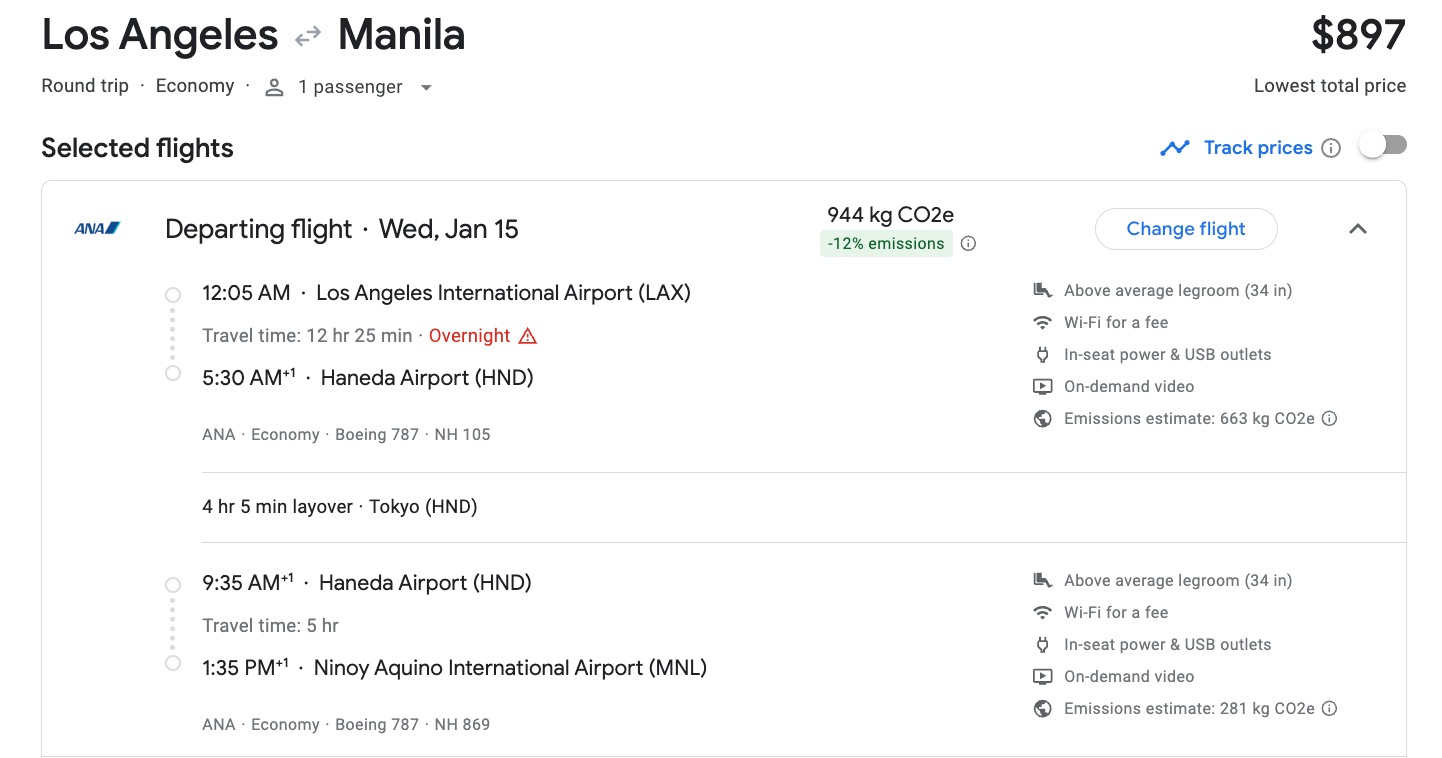
While you'll likely still have to get your passport checked at a transit desk at Tokyo-Haneda, it's highly unlikely you'll face the same long lines you would at immigration. In that case, a shorter connection should be fine.
But there are exceptions – especially in Europe.
If you're flying into one European airport and connecting to another – like this itinerary for a trip to Copenhagen (CPH) with a layover in Paris-Charles de Gaulle (CDG) – you'll clear customs and immigration when you land in Paris, not Denmark.
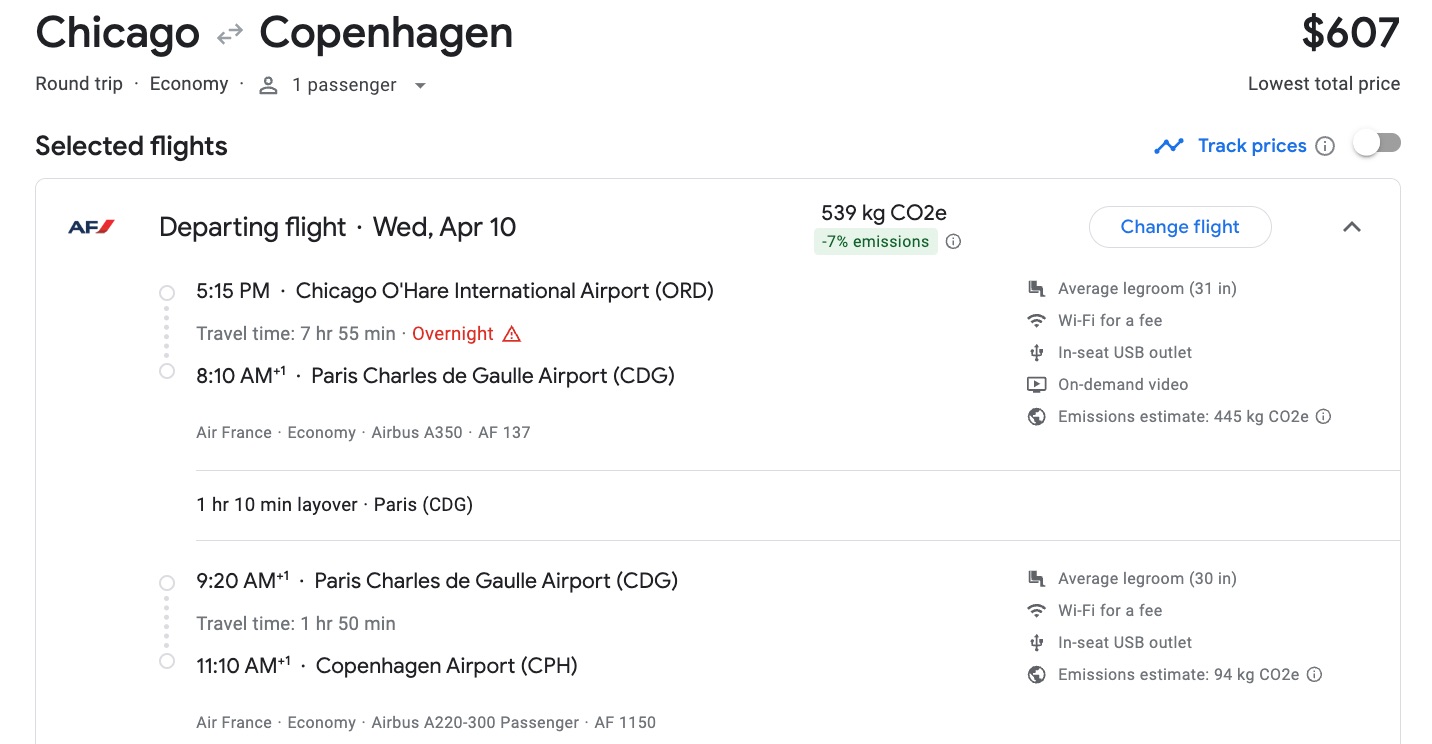
That's true for almost every country in Europe. You clear immigration upon arrival in Europe, then can travel freely from country to country without further passport checks.
The Single Best Tool for Determining if Your Connection is Long Enough
The best flight tracking app for travelers also has the best connection data analysis – go figure!
Flighty Pro was already our favorite travel app, but the addition of their new Connections Assistant feature makes it even more valuable. You don't have to guess anymore: Flighty will let you know exactly how risky your connection might be.
I had a recent itinerary with a connection in Miami (MIA), and I wasn't sure if the 95 allotted minutes would be enough. My app told me that the connection was definitely “Tight” but didn't fall into the category of “Risky.”
This international-to-domestic connection at Miami (MIA) had the number crunchers at Flighty slightly concerned for my ability to make it. Equipped with Global Entry, CLEAR® Plus, and PreCheck, I was able to breeze through to the gate in about 30 minutes, giving me about 20 minutes to spare before boarding.
For even better analysis on Flighty, you can actually tap that “Tight” icon for more information about what's ahead.
Flighty Pro is the single best way to analyze your connection to see if you have enough time.
Airports Where a Longer Connection is Better
Some airports are simply easier to navigate than others.
Small airports with just a few gates (or a single terminal), you don't need to worry – just land and walk to your next gate. But at some airports, you may need to walk 15-plus minutes, take a train, or even a shuttle bus to reach another terminal for your next flight. That might even require re-clearing airport security.
This is by no means an exhaustive list, but here are a few airports at home and abroad where you'd be wise to leave yourself with a longer layover.
U.S. Airports
If you booked flights on two separate itineraries, give yourself plenty of time between flights, especially if you're flying into one of these large, notoriously busy U.S. airports.
- Atlanta (ATL) is a huge airport where even connecting Delta flights can require lengthy walks from one terminal to another
- Chicago-O'Hare (ORD) can be problematic, especially if you're connecting between one of the main terminals and Terminal 5 for an international flight, although it's slightly easier with O'Hare's new (yet still infrequent) airside bus connections.
- Dallas-Fort Worth (DFW) is one of the largest airports in the world, and while all its terminals are connected by tram behind security, gate-to-gate connections can take a long time
- Denver (DEN) can be ridiculously bad due to intra-concourse train problems. Those haven't been as bad in 2025 as they were last year, though.
- Los Angeles (LAX) has a whopping nine different terminals, which can require up to 30 minutes of walking and sometimes re-clearing security, too
- New York-area airports (JFK, EWR, LGA) are notorious for delays due to backed-up arriving flights – plus, JFK's many terminals require both an AirTrain ride and re-clearing security
- Washington, D.C.-Dulles (IAD) has a wonky layout that can make it difficult to find your gate if you're unfamiliar with the airport
International Airports
- Bangkok (BKK) is a popular jumping off point to connect throughout Southeast Asia, but it's not the most efficient airport – nor easy to navigate
- Frankfurt (FRA) can be a gauntlet after landing from an international flight, with backed-up immigrations lines, too
- Istanbul (IST) seems impossibly massive, with walks of up to 20 minutes from your gate after landing to immigration
- London-Heathrow (LHR) might just be the worst airport in the world for making a connection, period
- Madrid (MAD) is huge, often with long walks from gate to gate – even within the same terminal
- Paris-Charles de Gaulle (CDG) isn't much better than Heathrow for making a connection whether you're flying internationally or within Europe
What to Do If You Miss Your Connecting Flight?
Missing a connecting flight due to a delay is the stuff of travel nightmares. It helps to know your options.
Sometimes, something within the airline's control like mechanical or scheduling issues will delay your flight and cause you to miss your connection. In that case, the airline will rebook you on another flight at no additional cost.
Your airline may do this automatically, or you may need to head straight to the customer service desk as soon as you land. While you wait, exhaust your options for getting help. Check the airline's app to see if you can rebook yourself, try contacting an agent via chat, phone, or even reaching out to the airline on social media.
Under U.S. Department of Transportation regulations, if an airline significantly delays your flight and you choose not to accept their rebooking options, you're entitled to cancel your reservation a full refund – not a credit or a voucher, but your money back.
When you miss a flight due to something within your control, like dilly-dallying too long in a lounge or getting lost on the way to your gate, your options can get much slimmer. The best thing you can do is ask nicely for the airline to rebook you on another flight. And while most airlines will help you out with rebooking, it's not a guarantee.
Tips for Getting Through the Airport Faster
Pack in Just a Carry-On Bag
No matter where you're traveling or how long you'll be there, we encourage travelers to try packing in just a carry-on bag to save money and time. But if you're faced with a tight connection on an international trip, it can be a godsend.
In some cases, like when arriving back in the U.S., you'll have to collect your bag from baggage claim, go through customs, and recheck it before boarding your connecting flight. Packing in carry-on bag instead could be the difference between making your connection or missing it.
Not convinced you can fit it all in one suitcase? Follow our tips for how to pack a carry-on bag for any trip!
Check In Online
The last thing you want to do on a tight connection is waste time checking in at the kiosk.
Whether you're flying the same airline or connecting on a different carrier, get all your boarding passes on your phone and ready to go. So long as you don't need to re-check your bag, that allows you head straight for your gate after you land.
Select a Seat at the Front
The sooner you get off the plane, the sooner you can start making your way to your next gate. But if you're at the back of the plane, you're probably getting off last – even if you stand up right when the boarding door opens.
On most airlines, you can pick your seat for free so long as you book a main cabin economy ticket – not basic economy. Even then, ponying up a few extra dollars to secure a seat even closer to the front of the plane could mean you'll get off the plane even sooner, saving you precious minutes to make your next flight.
When they know people onboard will be cutting it close, the flight crew might ask your fellow passengers to stay seated and let you off first. But do they listen? Not always.
Look up Directions to Your Gate in Advance
There's nothing worse than getting off a flight and being completely in the dark about where to go next. When time is tight, you want to prepare in advance.
Check which gate and terminal you're flying into – and where your next flight departs from. Pull up the airport map to figure out how to get there.
Save yourself the extra time (and stress) by figuring out which way you need to go before your plane even touches down.
Get Global Entry or TSA PreCheck
Global Entry and TSA PreCheck are two trusted traveler programs that can help you skip long lines and get through the airport quicker. They can be absolutely critical if you have a tight connection.
With Global Entry, you can clear immigration quickly after your international flight to get back into the U.S. After a recent trip to Europe, I landed in Chicago-O'Hare (ORD) to find a massive line for customs and immigration. It would have taken at least an hour, maybe more.
But Global Entry gets you access to a dedicated line that's always shorter, if not nearly empty. After snapping a quick selfie at one of the Global Entry kiosks (or via the Global Entry smartphone app), I walked over to an immigration agent, gave them my name, and walked through. The process took about 15 minutes and I was on my way.
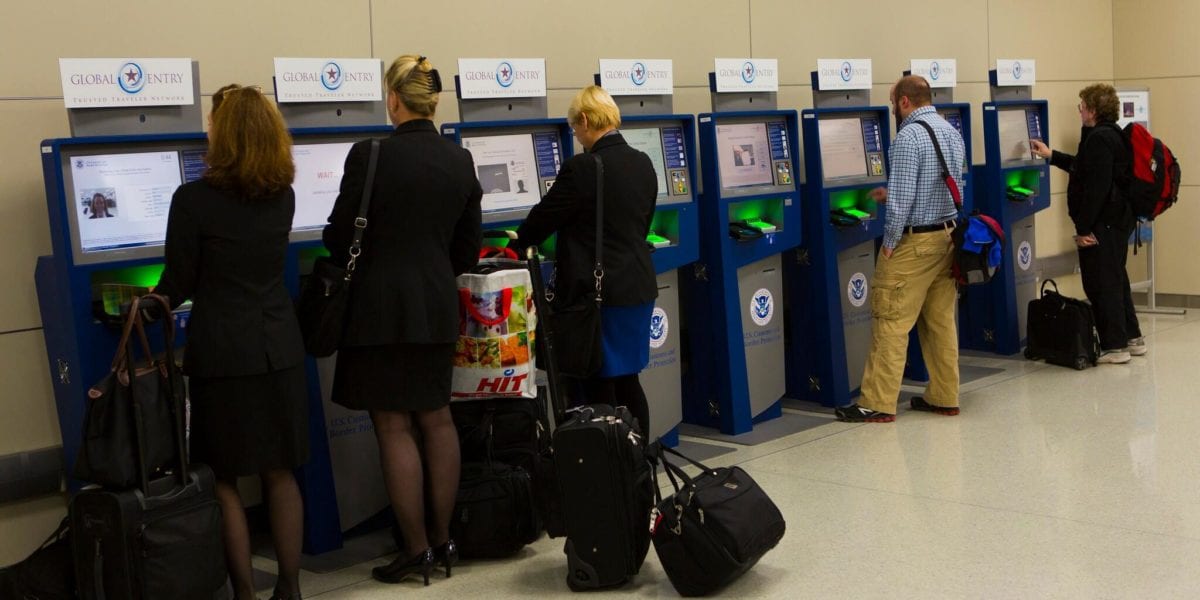
TSA PreCheck gets you into a shorter line at the airport security screening, where you get to keep on your shoes, belt, and a light jacket and leave liquids electronics in your bag. It's a huge time-saver when faced with long security lines, especially during busy times at the airport.
PreCheck costs $78 and is good for five-years, while Global Entry is $120 for a five-year membership – but that also includes PreCheck. The two services combined can save you a ton of time and make once-stressful connections a breeze.
Want TSA PreCheck or Global Entry? These credit cards will cover the cost!
Bottom Line
Determining whether a connection is long enough is one of travelers' top concerns. Unfortunately, there's no black-and-white answer.
It depends on where you're going and coming from and how you booked your ticket – and it all ultimately hinges on whether your first flight goes smoothly. But these general guidelines can help you book the right flights so you can stress less about making that connection.
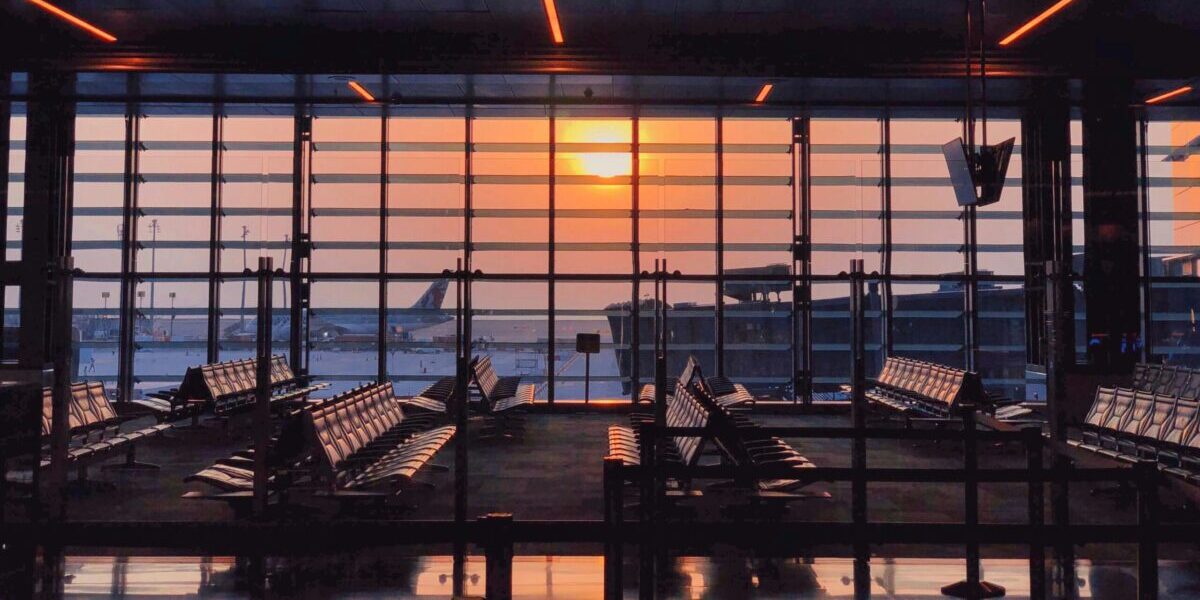



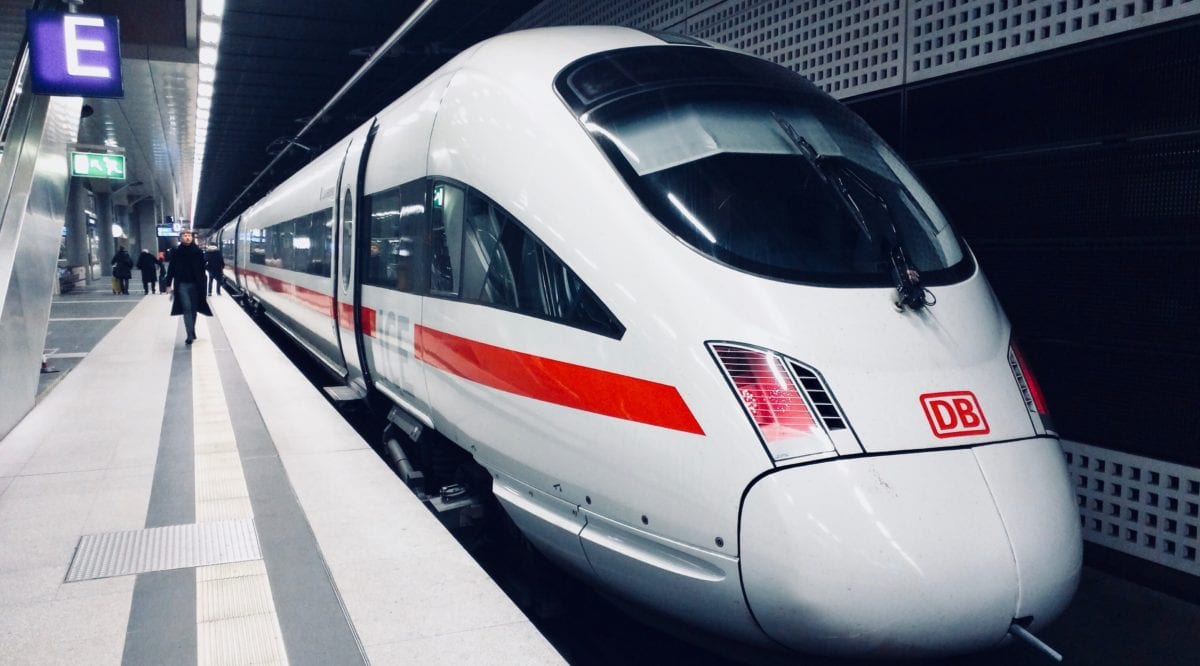

Agreed. “London-Heathrow (LHR) might just be the worst airport in the world for making a connection, period” Even with carry-on only and going direct from Delta Minneapolis flight at Terminal 3 to British Air Terminal 5 connection to Lisbon, two hours not enough. Boarding pass blocked 45 minutes before flight. BA no help to get on another flight. Had to pay £450 for anew one-way ($570)!!! Avoid London Heathrow, avoid British air, or give yourself no less than three hours for the connection.
For an important trip where I’m dealing with a domestic positioning flight where I don’t have at least six hours to connect I normally choose to stay overnight. For starters this is a good use of free night certificates, also it provides some flexibility on when to arrive at the airport for the long haul flight. As an example, this coming Xmas my family and I are leaving to Europe on the weekend beforehand. That would be fine in a low-demand period but if something screws up then I’m not at all sure we will be accommodated the next day if something goes wrong. So I am planning an overnight stay in the city we’re transiting to provide a buffer lest things go sideways. I view it as insurance.